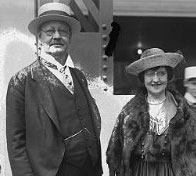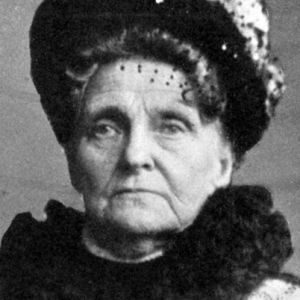
Colonel Ned Green and his bride Mabel Harlow Green shown shortly after their marriage in 1917. They made their home aboard a lavish passenger car named “Mabel” and traveled across North America. (Wikipedia photo)
Imagine knowing your mother was worth at least ninety million dollars ($90,000,000), yet you and your sister lived with her in the squalor of New York and New Jersey tenements. You grew up shy with no self-confidence. Once a boy slashed your leg with a knife. Your mother made the rounds of hospitals to find one that would treat your leg free. None did. You had to have your leg amputated. You wore cork prosthesis for the rest of your life. Such was the early life of Edward Howland Robinson Green (1868-1936).
The mother was Hetty Green, known to New York businessmen as the Wicked Witch of Wall Street. During the Gilded Age, Hetty was a big player in the Robber Barons who created an intricate web of ownerships, receiverships, and sales with the inability to pay interest on loans. By 1891 Hetty’s major feud was with Collis P. Huntington of the Southern Pacific Railroad. At stake was the Texas Central Railroad, a short line railway with decrepit equipment and disgruntled employees. For $75,000 in cash and three-quarters of a million dollars in Texas Central bonds, Hetty Green acquired the railroad.

Hetty Green, Ned’s mother, was known in New York financial circles as a miserly but brilliant businesswoman.
Immediately Hetty named her son, always known as Ned, as president and general manager of the newly christened Texas Midland Railroad. Everyone thought it was the greatest mistake Hetty ever made; Ned knew nothing about business. But Ned surprised everyone after Hetty opened her pocketbook with $1.8 million in cash. He turned the derelict railroad into one of the best short line railways in the country.
Shortly after obtaining the Texas Midland, the United States entered a national economic panic beginning in 1893 followed by the Pullman Strike of 1894. Yet, Ned Green managed to build 125.22 miles of main tracks, 37 miles of spurs, sidings, and yard tracks by laying heavier rails. He pioneered the art of “burnt combo” by burning heavy clay clods until they hardened like rocks to be used as ballast. And he bought only new locomotives. (Author added italics.)
His amazing passenger cars were instruments of new technology. He created the first café lounge cars, the first observation sleepers in the Southwest, the first electric locomotive headlights, the first steel boxcars, and after the introduction of automobiles the first high speed gas-electric railcar. By 1923 Texas Midland stock included 16 locomotives, 16 passenger cars and 183 freight cars.
In the late 1890s, the Texas Midland gained the reputation of hauling the largest tonnage of cotton in the country. When the boll weevil crossed the Rio Grande to damage Texas cotton, Green worked with state and Federal agricultural departments to buy, equip, and operate a model demonstration farm at Terrell, Texas, to combat the boll weevil.
Along the way Texas Governor O. B. Colquitt extended to Green the honorary title of “Colonel”. From then on Edward Howland Robinson Green was known as Colonel Ned Green. He became successful by hiring competent, loyal railroad officials with experience, and of course, gave them excellent salaries.
Before making it big in the railway business, Colonel Green met and fell in love with a vivacious redheaded prostitute named Mabel Harlow. She realized his disastrous childhood and the awkwardness of the cork leg. Mabel was a compassionate, kind woman who gave the large man self-confidence. The colonel was six feet, four inches tall and later in life weighed in at 300 pounds or more. Of course, the pocketbook sealed the relationship.
Colonel Green ordered a magnificent passenger car from George Mortimer Pullman. Described as “palatial” the car cost $75,000. Ned Green christened his new home “Mabel”. To aggravate local, state, and later Federal tax collectors, Green made the passenger car his legal residence, frequently moving it to another state or town when he suspected the tax collector was looking for him.
Colonel Green swore he would never marry while his mother was still living. Shortly after she died, Ned and Mabel were married on June 27, 1917. Colonel Green died in 1936. It took various counties, states, and federal officials over 29 months to settle the estate. His unmarried sister received the bulk of Hetty Green’s estate but Mabel received an ample $900,000 settlement.
One question remains. What happened to the elaborate passenger car “Mabel”? No one seems to know.

The TM line in Paris has not been used for over 55 years, yet Union Pacific will not allow us to place a trail there in honor of its existence.
I developed a PowerPoint on the Texas Midland for the annual Cotton Belt Symposium in Commerce a few years. I’m always on the lookout to share information.
Dennis Hogan